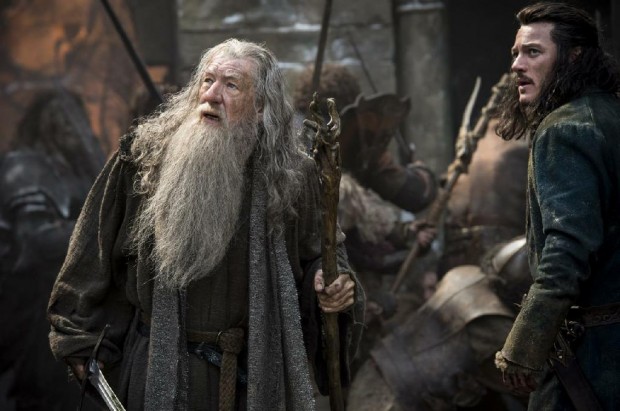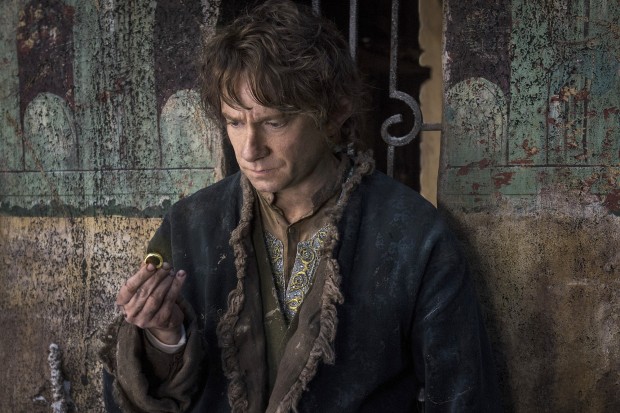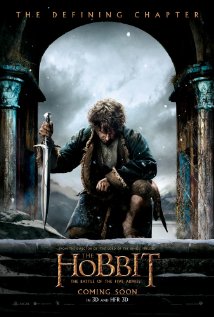There’s a moment early in The Hobbit: The Battle of the Five Armies that captures all of the restless and vivid immediacy that director Peter Jackson has frequently brought to his now six-film strong vision of J.R.R. Tolkien’s Middle-earth. Picking up directly from the last installment, Jackson visits a fantastical, apocalyptic firestorm upon the human denizens of Laketown, a water-logged province that has drawn the ire of the intimidating and tyrannical dragon Smaug (Benedict Cumberbatch). The last movie ended in haste with Smaug flying from his squatter’s den in Erebor, urged to wrath by Thorin Oakenshield (Richard Armitage), his company of dwarves, and their hobbit burglar Bilbo Baggins (Martin Freeman), but this one opens with a startling and rousing depiction of his consuming vengeance.
Homes burn to cinders, scurrying villagers scatter and splash to avoid cremation, and an entire lifestyle is roasted to pieces, all of it captured in a lilting, twirling dragon’s-eye view that sends audiences spinning through a kaleidoscopic furnace of tantalizing and terrifying visual mayhem. In this moment, Jackson the technical wizard, Jackson the fantasy dramatist, and Jackson the Tolkien fanboy all converge to create a sequence both poignant and grave, exciting and hair-raising. For a moment, all of the baggage accumulated over the last two movies—fatigue picked up by over-egged plotlines, indulgent, fatuous sequences, and needlessly contrived extra characters—is forgotten, and we are living in the wild and perilous realms of Middle Earth, perched atop the rooftops of Laketown with Bard (Luke Evans), as he makes one final, desperate stand to kill the taunting, merciless dragon.
It is a scene like this that endeared me to fantastical cinema to begin with, and more specifically, to Peter Jackson’s own overheated but passionate approach to rendering the worlds of Tolkien’s gentle, rollicking, alternate histories. If only the battle with Smaug represented more of the overall quality and final product that is The Battle of the Five Armies, or the Hobbit trilogy at large. Slathered with more of the rich, textured visual opulence these adaptations are known for, this closing chapter largely works as the action-heavy finale Jackson is going for, but it continually signals the director’s weaknesses more than it champions his strengths. Even that spectacular prologue falters because of its placement—enjoyable as it is, it belonged as the concussive conclusion of last year’s Desolation of Smaug—and its outright denial of Tolkien’s small but thematically significant detail of the thrush, who was always the miniscule and unsung hero of the dragon’s defeat.

Losing track of the small things is a common occurrence in Battle of the Five Armies, not least because that was also a genuine thread running through the last chapters of Tolkien’s novel and because Jackson is once again working on so large a scale that almost nothing but pure bombast remains in the enormous, special-effects heavy action scenes. There’s some real, genuine entertainment to be had in watching Thorin Oakenshield and his displaced dwarves return to their stolen home of Erebor, to seeing those crotchety wizards and elegant elves face off with an prototype version of the Dark Lord Sauron, and in witnessing armies of the dominant tribes of Middle-earth going at it in a skirmish that would lay the blueprints for that eventual War of the Ring.
Yet, much like that missing thrush, it’s Bilbo, the hobbit himself, who keeps getting pushed aside, and with him, the emotional heart of the story. Ironically, despite its status as the busiest, bloodiest and most action-packed segment of The Hobbit, this crowning dénouement was also the place where Tolkien quietly laid the emotional and spiritual crux of his story; hinged upon the desperate, greed-smitten Thorin and Bilbo, an unlikely friend and ally determined to see his company through safely even when it might mean betraying their current, stubborn resolve. Beyond that, this was no mere battle, no simple, preachy conflict designed to highlight the eroding qualities of material wealth, but—at the end of the day—a paen to the solidarity of fighting for goodness, tribalism and worldly allure be damned. So much of the simple, evocative power of that idea is lost here, replaced by spectacle aplenty, some of which is still rather impressive on a visceral level.
Although it takes a little while for Jackson to set up the primary struggle—a convergence of various interested parties at the foot of the Misty Mountains, each concerned with claiming their part of the Dwarven treasure—when an armada of orcs, trolls and various dark forces, led by Azog the Defiler show up to claim the stronghold for their own, the saga finally takes off. From Billy Connolly as Dain, the pig-riding general of Thorin’s dwarvish reinforcements, to a race of giant, fearsome Tremors-esque worms, Jackson strikes up the usual verisimilitude when introducing the newest characters and races featured in this full-tilt struggle. The technical credits are indeed amazing, but for one of the first times in any of the series, I felt a curious disconnect with the fantastical legions, yearning to spend more time with Bilbo and the dwarves, holed up and fuming in shadowy Erebor.

Freeman and Armitage have proven to be inspired casting over the course of the series and the two actors do their best work in this edition, both fully coming into their own as agents of their individual destinies. Armitage has a lot of overwrought, near operatic direction to overcome, but he cuts away at simple, grumpy caricatures and unpacks a noble, stubborn leader who has retreated so completely into those traits that they have taken him down a dark, twisted path. Playing his simple but direct conscience, Freeman surprises by allowing that innocence and earthy pragmatism of the Shire spill out of Bilbo this time, coupled with the changes this journey has brought to his sense of self. Jackson has a perfect stage set for their warring friendship, but he’s never content to showcase it. All other characters lose a little something here, including Gandalf (Ian McKellan), who has never looked wearier or more like raggedy set dressing. McKellan is an ace at grabbing a line of dialogue here or there and then detonating it so it resonates over several scenes, but he gets to do that so rarely, that I missed the great wizard despite his regular presence on screen.
Luke Evans’ Bard was one of my favorite characters in the last installment and his stand-off with Smaug and subsequent mustering of his broken people here do much to recall Aragorn from Lord of the Rings. However, when the action heats up, he too disappears as an emotional focal point, too often ceding to the elves, who are omnipresent but rarely interesting. I’m a fan of Lee Pace’s Thranduil and his prickly evolution within this particular story, but I’ve come to care very little for Tauriel (Evangeline Lily) and her love affair with dwarf Kili (Aidan Turner). Further complicating matters is simply too many extraneous characters, including the mystifying appearance of Ryan Gage as the sniveling acolyte of Stephen Fry’s too-little seen Master of Laketown. Gage’s Monty Python-lite depiction of medieval cowardice is poorly handled and his presence in the story appears limited to comedic relief, highlighted by the fact he simply disappears at one point, never to be heard from again.
It’s quite possible that Gage and several other elements, like those pesky mountain worms and shapeshifter Beorn, who gets one of the book’s finest heroic moments, have suffered here in favor of an eventual special extended edition of the film. Unfortunately, Jackson hasn’t quite earned the same fealty with this film that he so effortlessly obtained with Lord of the Rings. Before your fans are going to line-up for an bigger version, they need to be pleased with the first offering. Too much of The Hobbit: The Battle for the Five Armies coasts by on the goodwill of the faithful.
As a result, the movie is another entertaining bout of a big kid playing in a vast special effects sandbox, but little else. That will be good enough for the Christmas box office, sure. But what about that last, desperate stand of the King Under the Mountain? Don’t Thorin and company deserve a more fitting send-off than split apart to fight their own bland, individual Orcs? What we needed was visual poetry bold enough to riff on Tolkien. What we too often get here is Hobbit: The Nintendo Game.
The Hobbit: The Battle of the Five Armies is now playing in wide release.

